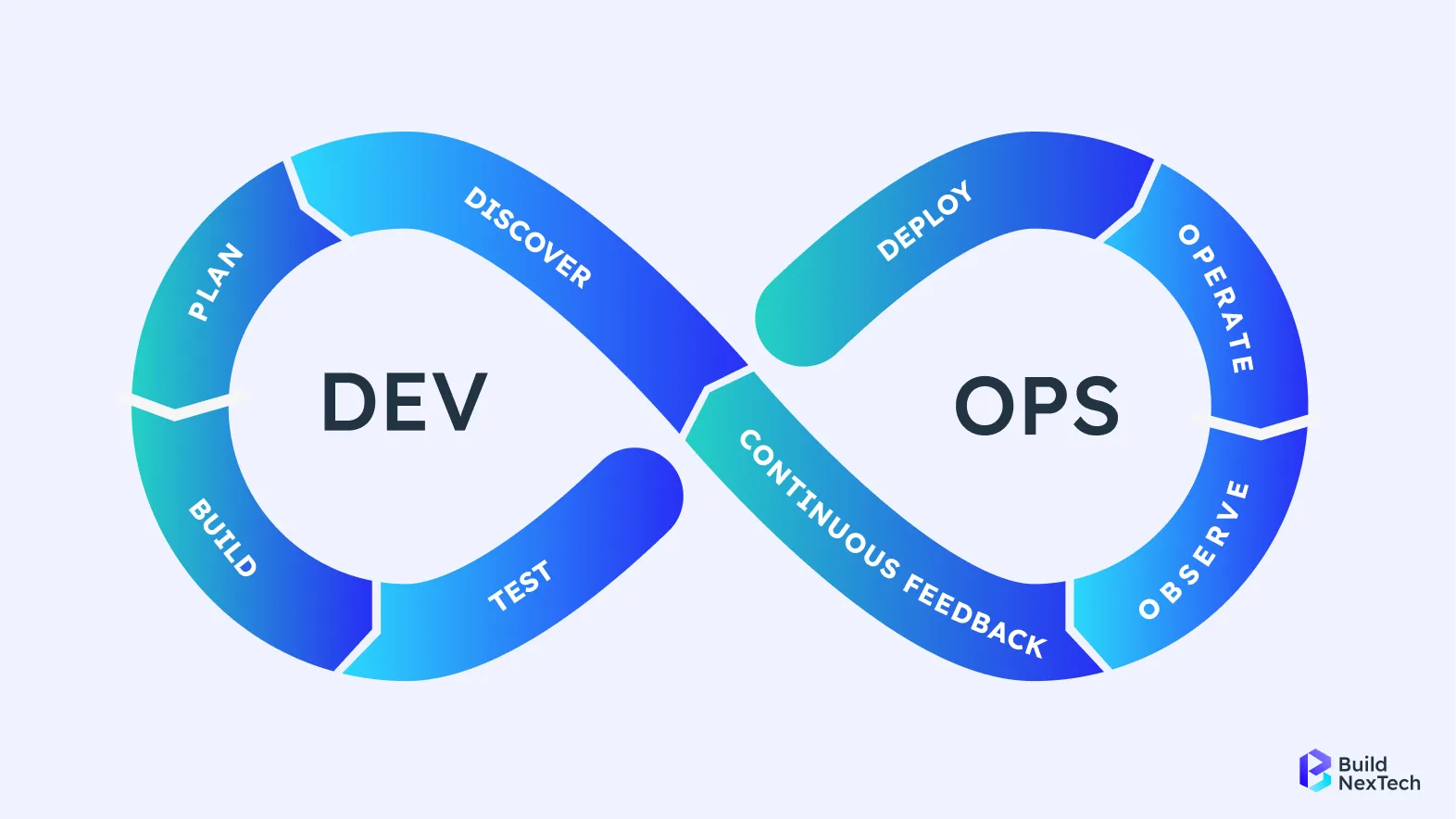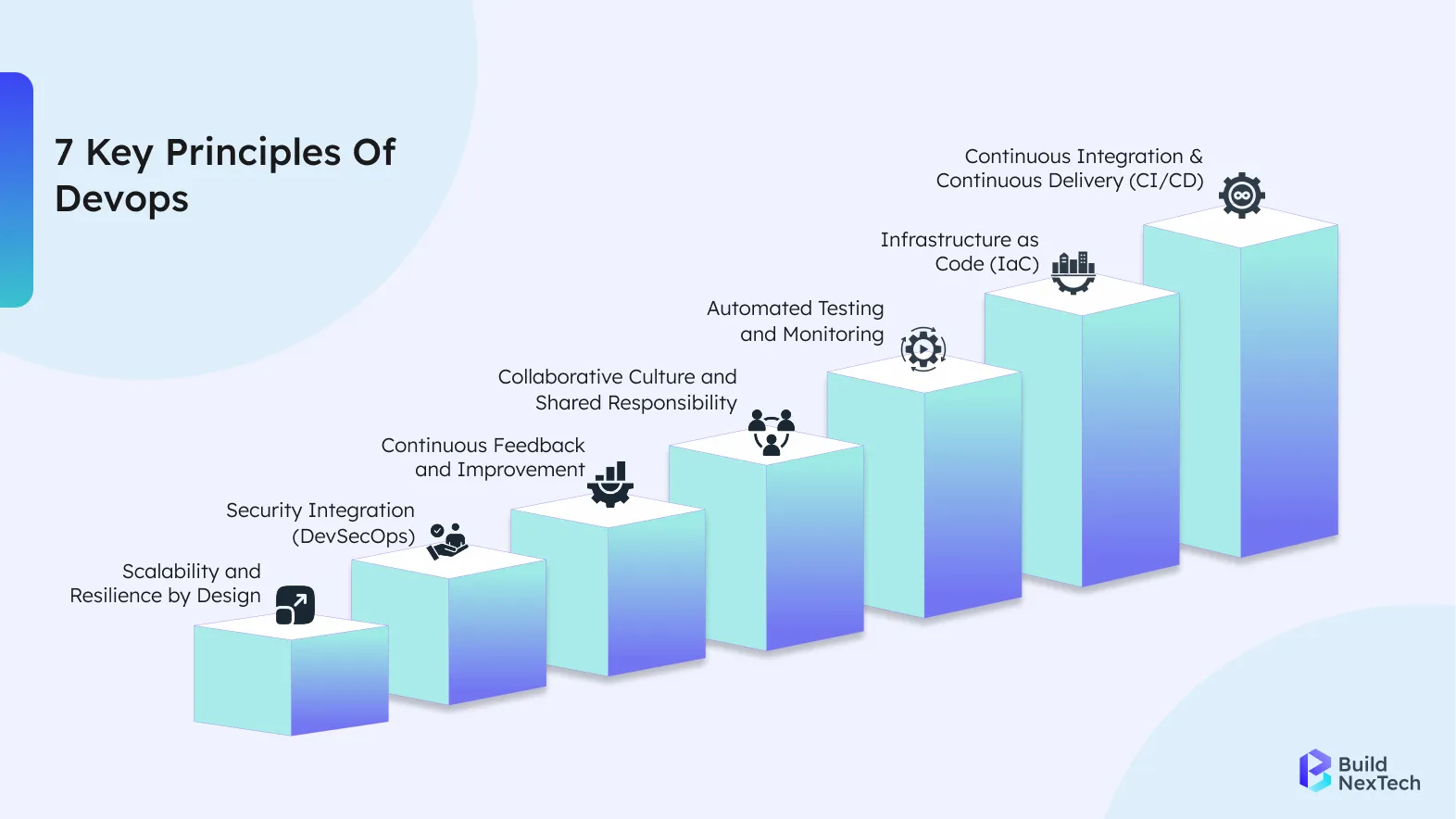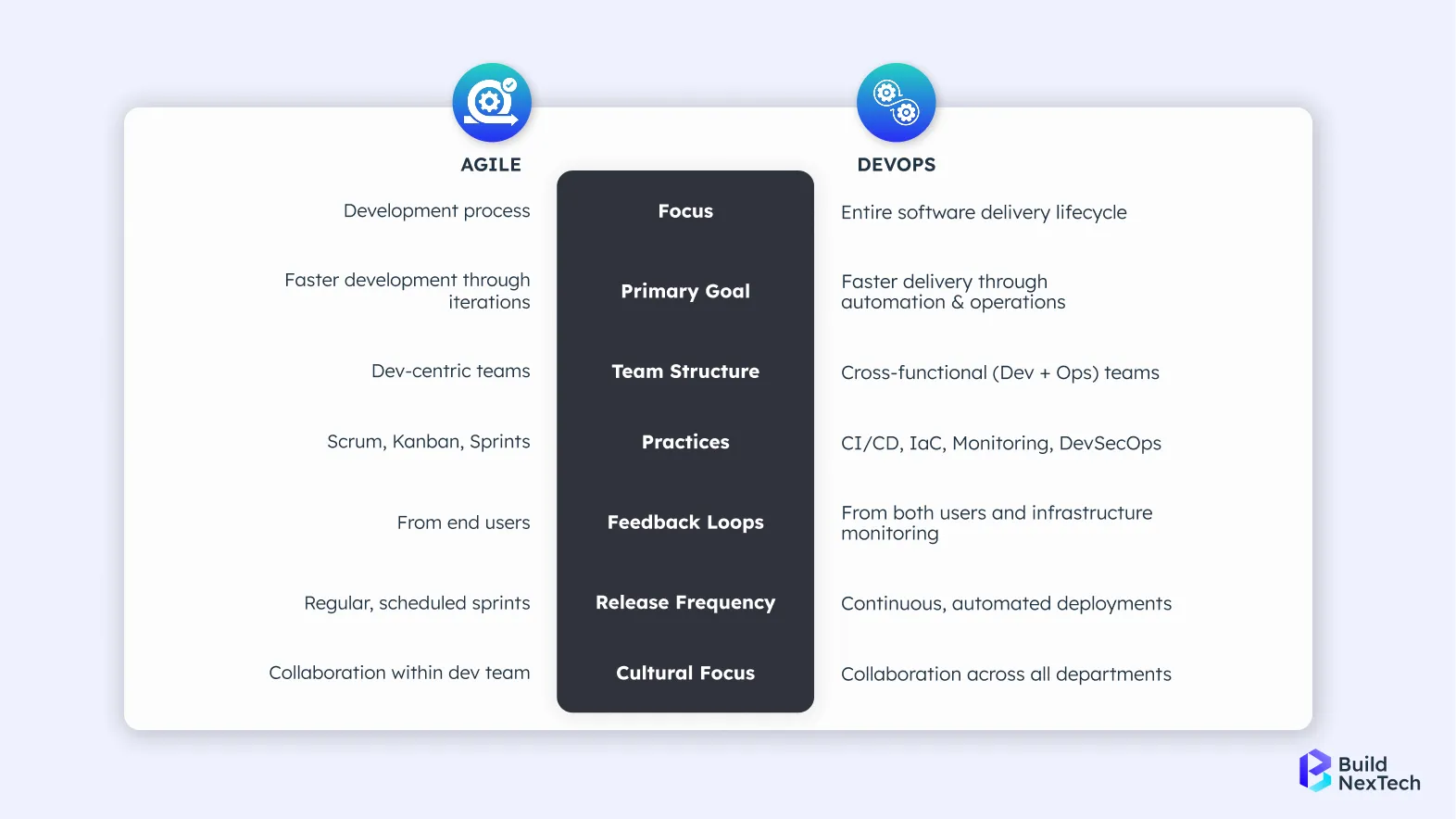DevOps isn’t just a set of tools, it's a mindset shift that unifies development and operations to build, test, and deploy software faster and more reliably. As businesses across the globe embrace digital transformation, understanding the core principles of DevOps becomes essential for driving innovation, reducing deployment risks, and ensuring continuous improvement. In this guide, we’ll walk you through the 7 foundational principles that make DevOps successful, helping your teams deliver better software and elevate customer satisfaction with every release.
💡 Key Insights
📌Understand core DevOps principles for faster, reliable software delivery.
📌 Differentiate DevOps vs Agile and how they work together.
📌 Learn CI/CD, IaC, and DevSecOps implementation strategies.
📌 Discover best practices to avoid common DevOps pitfalls.
📌 See how DevOps fuels growth for top web development companies.
What is DevOps?
DevOps is a set of practices that combines software development (Dev) and IT operations (Ops) to shorten the development lifecycle and deliver high-quality software continuously. It emphasizes:

- Collaboration: Breaks down silos between development, operations, QA, and other teams.
- Automation: Streamlines repetitive tasks like testing, deployment, and infrastructure provisioning.
- Continuous Integration & Delivery (CI/CD): Enables frequent, reliable code releases.
- Monitoring & Feedback: Promotes proactive incident management and performance optimization.
- Cultural Shift: Encourages shared responsibility, transparency, and continuous improvement.
DevOps helps teams deliver better software, faster - boosting customer satisfaction and business agility.
What Does a DevOps Engineer Do?
A DevOps engineer plays a vital role in modern software teams by bridging the gap between development and operations. They implement core DevOps principles such as workflow automation, Infrastructure as Code (IaC), continuous integration and delivery (CI/CD), and proactive monitoring. These engineers enable seamless collaboration between cross-functional teams to ensure high-quality, reliable, and faster software delivery.
Key Responsibilities of a DevOps Engineer include:
- Automating Software Delivery Pipelines:
Designing and maintaining CI/CD workflows to enable faster and more frequent releases with minimal manual intervention. - Infrastructure as Code (IaC):
Managing and provisioning infrastructure using code-based tools like Terraform, CloudFormation, or Ansible. - Monitoring and Incident Management:
Setting up logging, monitoring, and alerting tools (e.g., Prometheus, Grafana, ELK Stack) to ensure system reliability and quick response to failures. - Collaboration and Communication:
Working closely with developers, QA, and IT operations to ensure consistent environments and smooth deployment practices.
Why DevOps Matters for Modern Teams
Today's software teams must quickly deliver robust, reliable software. DevOps offers a structured approach by emphasizing collaboration, boosting deployment frequency, and prioritizing customer satisfaction through continuous feedback, automated deployments, and rapid adaptability. It breaks traditional departmental silos, aligning development and operations towards shared objectives and mutual success. In an increasingly competitive market, adopting DevOps practices is crucial for organizations to thrive and maintain their competitive edge.
Introduction to DevOps Principles and Practices
DevOps has transformed software development by seamlessly integrating development and IT operations, enabling teams to produce high-quality software rapidly. Mastering these core principles is critical for a successful DevOps transformation. With DevOps, organizations enhance collaboration, streamline operational workflows, and accelerate product delivery cycles, becoming more agile, responsive, and customer-centric.

Principle 1: Continuous Integration & Continuous Delivery (CI/CD)
Continuous Integration (CI) involves frequently merging code into a central repository and validating changes with automated testing. CI minimizes integration challenges that often surface late in the software lifecycle. Continuous Delivery (CD) automates code preparation for production, significantly reducing deployment frequency, minimizing change lead time, and decreasing the change failure rate. Tools like Jenkins, GitLab CI/CD, and Travis CI facilitate efficient CI/CD automation, enabling quicker, more dependable software delivery.
Principle 2: Infrastructure as Code (IaC)
Infrastructure as Code (IaC) manages and provisions infrastructure through code, increasing transparency, reducing errors, and enhancing efficiency. Using IaC, teams can apply software development practices such as version control and automated builds to infrastructure management. Popular tools like Kubernetes, Chef Automate, Terraform, and CloudBees support effective infrastructure automation, scalability, and consistency, enabling rapid deployment cycles and agile responses to evolving demands.
Principle 3: Automated Testing and Monitoring
Automated testing ensures reliability through continuous validation processes, significantly reducing deployment risks and streamlining validation. Incorporating test automation into deployment pipelines ensures only thoroughly tested code reaches production environments. Simultaneously, comprehensive monitoring and logging services like Prometheus, Datadog, and Grafana provide proactive issue detection, efficient incident management, and insightful feedback loops, driving continuous improvement and transparency.
Principle 4: Collaborative Culture and Shared Responsibility
DevOps transformation requires a meaningful cultural shift, eliminating departmental silos and fostering open communication, transparency, and collaboration across cross-functional teams. Collaborative tools such as Slack, Jira, Confluence, and Microsoft Teams support this cultural change, enabling effective communication and facilitating collective responsibility. A strong collaborative culture promotes active participation in software delivery, incident resolution, and continuous improvement, resulting in greater organizational resilience.
Principle 5: Continuous Feedback and Improvement
Continuous feedback loops, implemented through collaborative software tools, ensure transparency and drive continuous improvement throughout the software development lifecycle (SDLC). Regular customer feedback allows teams to refine software features, enhance developer productivity, and achieve higher customer satisfaction. This iterative, feedback-driven approach enables organizations to rapidly adapt to customer needs, market shifts, and performance objectives, driving sustainable growth and continuous development.
Principle 6: Security Integration (DevSecOps)
DevSecOps integrates security practices directly into the CI/CD pipeline, embedding automated security testing and validation early in the development process. Tools like OWASP ZAP, SonarQube, and InSpec identify and mitigate vulnerabilities proactively, enforcing compliance and maintaining robust security standards. DevSecOps ensures security integration without compromising agility or deployment speed, significantly reducing security incidents and ensuring reliability.
Principle 7: Scalability and Resilience by Design
Designing for scalability and resilience involves leveraging cloud infrastructure, microservices architectures, containerization technologies (Docker, Kubernetes, Linux containers), and cloud computing services (AWS, Google App Engine, Windows Azure). This strategic design approach ensures applications efficiently scale to meet fluctuating customer demands and remain consistently reliable amidst market changes. It allows organizations to manage resources dynamically, responding rapidly to emerging business opportunities and customer requirements.
DevOps vs Agile: Key Differences and How They Work Together
Understanding the difference between DevOps and Agile is crucial for businesses aiming to optimize both speed and stability in software delivery. Recognizing how these approaches differ and how they complement each other helps organizations align teams, reduce time-to-market, and build scalable, customer-focused solutions.

DevOps Best Practices for Successful Adoption
Implementing DevOps effectively requires more than adopting new tools; it demands strategic alignment with existing processes and a cultural shift across teams. By following key best practices and avoiding common pitfalls, businesses can ensure smoother DevOps adoption, improve team efficiency, and achieve faster, more reliable software delivery.
How to Align DevOps with Agile Methodologies?
Integrating DevOps with Agile helps businesses deliver better software, faster. This alignment bridges the gap between development and operations while maintaining the agility needed to adapt to changing customer needs.Some of the key benefits of this integration are outlined below:
- Streamlined Workflows: Combining Agile’s iterative approach with DevOps automation enables smooth, end-to-end development pipelines.
- Faster Feature Deployment: Continuous integration and delivery accelerate release cycles and reduce time-to-market.
- Improved Software Quality: Agile testing and DevOps monitoring lead to early detection of issues and more stable releases.
- Better Developer Experience: Shared responsibilities and improved tooling enhance collaboration and productivity.
- Higher Customer Satisfaction: Transparent, iterative updates aligned with user feedback help meet evolving customer needs.
- Stronger Market Competitiveness: The combined agility and operational efficiency give businesses a strategic edge.
What are the Common Pitfalls to Avoid in DevOps?
While adopting DevOps can drive major benefits, many organizations face challenges that hinder successful implementation. Being aware of these common pitfalls can help you avoid costly setbacks and ensure a smoother transformation. Some of the most frequent issues include:
- Inadequate Training: Teams lack the skills needed to adopt new tools and practices effectively.
- Poor Cultural Alignment: Resistance to change and lack of shared ownership slow down adoption.
- Ineffective Communication: Silos between teams lead to misunderstandings and missed handoffs.
- Inadequate Logging & Monitoring: Lack of visibility into systems causes delayed incident response.
- Underutilized Automation Tools: Failing to leverage automation results in manual errors and inefficiencies.
Conclusion: Transforming Your Organization with DevOps
Successfully adopting these seven core DevOps principles significantly enhances software delivery, reduces lead times, and boosts customer satisfaction. By embracing DevOps best practices, organizations achieve continuous improvement, adaptability, and sustained competitive advantage.
At BuildNexTech, a leading web development company and website development company, we believe that robust DevOps transformations empower businesses to achieve rapid innovation, proactively respond to customer demands, and deliver measurable outcomes. Whether you’re seeking website development services or partnering with a top-tier web development agency, integrating DevOps positions your organization for long-term success in a dynamic digital landscape, helping you stay ahead of other web development companies in the United States.
People Also Ask
How can DevOps automation tools improve workflow efficiency and reliability?
DevOps automation tools streamline workflows, reduce manual errors, and enhance reliability by automating repetitive tasks and enabling consistent software releases.
What are the best DevOps practices to follow for scalable application deployments?
Best DevOps practices for scalable deployments include leveraging Infrastructure as Code (IaC), robust CI/CD pipelines, containerization, cloud infrastructure, and continuous monitoring.
What’s the difference between DevOps and DevSecOps?
DevOps vs. DevSecOps: DevOps integrates development and operations for faster releases, whereas DevSecOps additionally embeds security practices into the entire development lifecycle.
How does DevOps contribute to reducing time-to-market for software products?
DevOps reduces time-to-market by automating deployments, enhancing collaboration, enabling continuous integration and continuous delivery, thus speeding up software releases.


























.webp)
.webp)
.webp)

